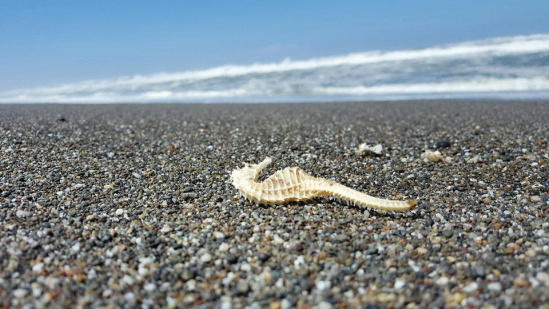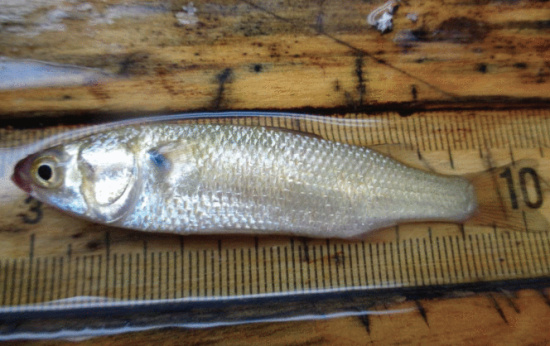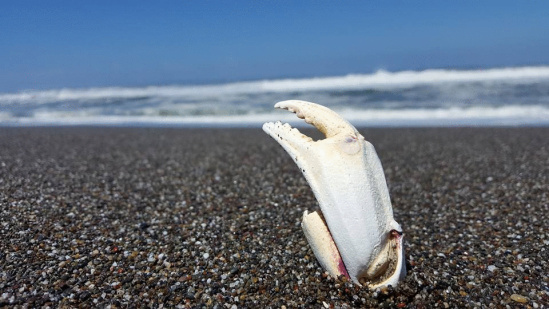Photo taken by Dennis Finley Jr. of Fortuna.
A Humboldt County man made a potentially record-breaking scientific discovery while walking with his family at Centerville Beach on Sunday.
Dennis Finley Jr. of Fortuna was snapping some photos of a family beach day when he says he happened upon the seahorse skeleton pictured above, an ultra-rare find for any Northern California beach.
“I understood how rare it was to see something like that here,” Finley told the Outpost via Facebook messenger. “I did not pick it up but just took pics of it. Pretty cool thing to see. If it was from our area, it’s super rare and cool. If it washed on the tide current and ended up here, it’s a super rare beach lotto score.”
Humboldt State Fisheries and Biology Department Chair Andrew P. Kinziger told the Outpost via email that the skeleton is an amazing find, as the Pacific seahorse habitat typically ranges from Northern Peru to San Diego. However, he noted that the find should be handled with healthy skepticism unless studies can prove the skeleton reached Humboldt shores naturally.
“I’ve never heard of seahorses in Humboldt or Del Norte counties, so it would be quite an amazing find if it were true,” Kinziger said. “We do have bay pipefishes in Humboldt Bay and surrounding areas, which are in the same family as seahorses, and they are quite common. However, pipefishes are long and pencil-like, and unlikely to be confused with a seahorse.”
A striped mullet in the Salmon Creek estuary last year. By California Department of Fish and Wildlife..
Kinziger also noted that several other fish species typically native to waters south of San Francisco were recorded around Humboldt Bay in the last year. Kinziger co-authored a paper last year on the California Department of Fish and Wildlife’s discovery of several striped mullet in the Salmon Creek estuary in June of 2015, the first recorded finding of this species north of San Francisco. A Pacific butterfish was also recorded in Humboldt County last year, which Kinziger said has been recorded in local waters before, but was still a special find.
HSU Emeritus Professor of Ichthyology Ron Fritzsche, who specializes in the study of seahorses and pipefish, also said via email that the skeleton in the photo does appear to be that of a Pacific Seahorse.
“This alternative is not likely but possible,” Fritzsche said. “Someone could have purchased a dried seahorse at a Chinese medicinal shop in San Francisco, then dropped it on the sand and took a photo. So it’s important to see the specimen if possible. However it does look like [a Pacific Seahorse]. I thought of this possibility because years ago another graduate student brought me a dried tropical pipefish (Syngnathoides biaculeatus) that he said was from San Diego Bay. Turns out it was a practical joke.”
Fritzsche said the northernmost record of a Pacific Seahorse was observed in 1870 by scientist Alexander Agassiz.
“They are typically not found north of Magdalena Bay, Mexico,” Fritzsche said. “But [they] can appear during warm water events, e.g. the power plant outfall in San Diego Bay. Agassiz’s find occurred during an El Niño year. So perhaps this one is related to that event as well. In any event, it is a northern record.”
Retired marine biologist for the California Department of Fish and Game Robert N. Lea also speculated via email that although a seahorse in Humboldt County is highly unusual, it is not impossible during an El Niño year.
“I think every effort should be made to get the specimen for Ron [Fritzsche] to examine. He knows this group as well as anyone,” Lea said. “A fair number of Pacific Seahorses have been taken in southern California this year and there is one record from slightly north of Point Conception. I agree with Ron; this alternative is not likely but possible. I think this could turn out to be an important publication if Ron can verify the specimen, even if there is some speculation involved. If one can get Striped Mullet into Humboldt County, why not Pacific Seahorse?”



CLICK TO MANAGE